THE American WESTERN
By Jeffrey-Baptiste Tarlofsky
By Jeffrey-Baptiste Tarlofsky
Lesson 29 consists of 10 video lectures and transcripts of those lectures, and 8 film excerpts. Start with the lecture, Part 1 and continue down the page in sequence until you reach the end of the lesson.
レッスン29は、10本のビデオレクチャー(レクチャーのテキストがビデオレクチャーの下に記載されています)と8本の動画で構成されています。
このレッスンは、最初のLecture Part 1から順番に動画を見たりテキストを読んでください。
Part 1 – John Ford had one of the longest careers in Hollywood history. One reason his career endured for so long was that he, more than almost any other director, had the capacity to learn, grow, and change. Nowhere is this ability more in evidence than in Ford’s depiction of the American Indian. In Stagecoach and Drums on The Mohawk, the Indians are depicted in an almost completely negative light. Ten years later, in She Wore a Yellow Ribbon, Ford starts to show us that even while the Indians remain bad, whites can in some cases be worse. Seven years after She Wore a Yellow Ribbon, Ford would evolve still further along this path when he made a film many critics have come to call his greatest Western, The Searchers (1956).
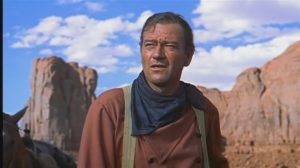 My own opinion of this film is mixed, even conflicted. It is certainly a beautifully made him, but one that has some very ugly flaws. We will see both in the excerpts that follow. However, regardless of its flaws, The Searchers is an important film. In this film, Ford delved very deeply into the darkest part of human nature. Remarkably, the actor he chose for this exploration is none other than John Wayne. Perhaps we should not be so surprised by this. Wayne was, after all, quite versatile in some respects. In 1939, he played the teenaged Ringo Kid while a mere ten years later in 1949 he played the old cavalry officer, Nelson Brittles, preparing for retirement in She Wore A Yellow Ribbon. Again in 1962, he would play the “young” Tom Doniphon and less than a decade later he would win his only Academy Award for playing an aging, drunken Marshall Rooster Cogburn in True Grit (1969). If age presented no challenge to Wayne, then neither did playing morally complex characters such as Thomas Dunson, who would kill a man for land but see that he had a proper burial after, or Tom Doniphon, who would commit murder to protect the man who stole the girl he loved. His character in The Searchers, Ethan Edwards, has been called the most complex character Ford and Wayne ever created together. He is certainly the darkest. We will meet him now in the opening scene of the film.
My own opinion of this film is mixed, even conflicted. It is certainly a beautifully made him, but one that has some very ugly flaws. We will see both in the excerpts that follow. However, regardless of its flaws, The Searchers is an important film. In this film, Ford delved very deeply into the darkest part of human nature. Remarkably, the actor he chose for this exploration is none other than John Wayne. Perhaps we should not be so surprised by this. Wayne was, after all, quite versatile in some respects. In 1939, he played the teenaged Ringo Kid while a mere ten years later in 1949 he played the old cavalry officer, Nelson Brittles, preparing for retirement in She Wore A Yellow Ribbon. Again in 1962, he would play the “young” Tom Doniphon and less than a decade later he would win his only Academy Award for playing an aging, drunken Marshall Rooster Cogburn in True Grit (1969). If age presented no challenge to Wayne, then neither did playing morally complex characters such as Thomas Dunson, who would kill a man for land but see that he had a proper burial after, or Tom Doniphon, who would commit murder to protect the man who stole the girl he loved. His character in The Searchers, Ethan Edwards, has been called the most complex character Ford and Wayne ever created together. He is certainly the darkest. We will meet him now in the opening scene of the film.
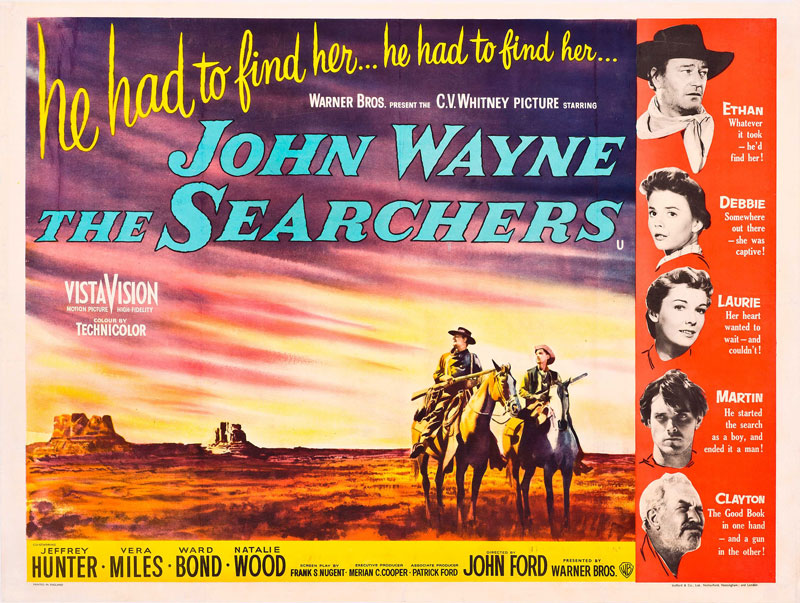
Directed by John Ford
Screenplay by Frank S. Nugent – Based on The Searchers 1954 novel by Alan le May
Starring John Wayne, Jeffrey Hunter, Vera Miles, Ward Bond, Natalie Wood
Music by: Original score by Max Steiner
Title song: Stan Jones
Running time: 119 minutes
Budget: $3.75 million
Part 2 – Ethan is a Confederate veteran of the Civil War who at long last returns to his family in Texas in 1868, fully three years after the end of the war. Why did it take him three years after the war to return home? The fact that he has freshly-minted money, which he gives his brother, suggests that Ethan may have spent the last three years as an outlaw. One of The West’s most famous outlaws, Jesse James, was a Confederate veteran who robbed banks he believed had supported the Union cause. Outlaw Ethan may be, but he is also kind and generous to his family. However, when Martin, an orphan boy his family has adopted shows up for dinner, Ethan is suspicious of his dark complexion and remarks on this. When Martin admits he is “one-eighth Cherokee” Ethan instantly becomes colder towards him. This is the first hint we have of Ethan’s racism.
The next morning the local leader of the Texas Rangers, the Texas state police, shows up to recruit men for a posse to look for whoever has rustled (stolen) a local rancher’s cattle. The discovery is soon made that the cattle theft was only a diversion and that something much worse is about to happen.
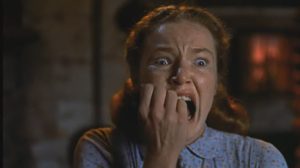 Part 3 – The Comanche have stolen the cattle only to draw the armed white settlers away from their farms. At dusk, they approach Ethan’s family’s farm. The most memorable moment in this part of the film occurs when the older daughter, Lucy, realizes why her mother doesn’t want her to light the lantern. Ford zooms in for a close-up as she screams (and this scream is really something. It even challenges Lana’s scream in Drums On the Mohawk when she sees Blue Black). Ethan and Martin arrive too late to save the family. Father, mother, and son have been killed, but the two girls have been kidnapped.
Part 3 – The Comanche have stolen the cattle only to draw the armed white settlers away from their farms. At dusk, they approach Ethan’s family’s farm. The most memorable moment in this part of the film occurs when the older daughter, Lucy, realizes why her mother doesn’t want her to light the lantern. Ford zooms in for a close-up as she screams (and this scream is really something. It even challenges Lana’s scream in Drums On the Mohawk when she sees Blue Black). Ethan and Martin arrive too late to save the family. Father, mother, and son have been killed, but the two girls have been kidnapped.
So, at last, Ford gives us a story about the one thing whites feared the most: the kidnapping of white women by the Indians. Ford also chooses to make the tribe that does the kidnapping — the Comanche — the most feared and hated of all the Indian tribes that came into conflict with the whites. I have already explained in an earlier lesson that the Comanche were by far the most powerful of the Indian tribes in the West and at one time controlled a vast empire in the Southwest that included large parts of Texas. The Comanche were so aggressive that they actually drove the Apache from their ancestral hunting grounds. Their reputation for ferocity was certainly well earned, but the Comanche, like many other Indian tribes of North America, also practiced the custom of adoption (which you can read about below)
At first, the Rangers all go looking for the missing girls, but after a brief battle with the Comanche, the Captain of the Rangers tells Ethan that he will have to continue the search alone because he has to take the wounded back to civilization. However, both Martin and Lucy’s boyfriend, Brad, insist on going with Ethan, and the three of them continue to search for the missing girls. You now know why the film is called “The Searchers”.
We have to remember that when we say “the Indians”, we are talking about hundreds of different tribes and sub-tribes each with their own languages, cultures, and living situations. How prisoners were treated depended on a number of factors, the most important of which was which tribe they had been captured by. The age and sex of the captive was also very important. Adult prisoners were far more likely to be tortured and killed than children. Adult males or older male children were also more likely to be tortured and killed than females. However, children of either sex under the age of twelve were very often “adopted”. This was a custom that was totally confusing to white settlers. Indians sometimes raided white settlements in order to capture children to adopt. Whites never did this. The Indians had no concept of “race”. The primary distinction among the Indians was between “my tribe” and “not my tribe” (although certain tribes would be considered friendly while others would be considered enemies). For whites the primary distinction was racial. If you were not “white” you were the racial “other”, which meant your life did not have the same value as a white life. This was how whites justified enslaving Black Africans and committing genocide against the Indians. It was also why no non-white person was ever fully accepted into white society. Whites simply did not accept people of other races. On the other hand, the Indians of one tribe might consider their enemies in another tribe to be “worthy” enemies. Warfare between the tribes frequently led to dangerous losses of population. This was why the custom of adoption was so common. If one tribe raided another and lost three warriors in the fight, but captured ten children from the other tribe, they would have gained a total of seven new future members of the tribe. In other words, for whites, an Indian was always “the other” because of his race, but for the Indians, it was possible for someone of any race to become a member of their tribe if they had been adopted.
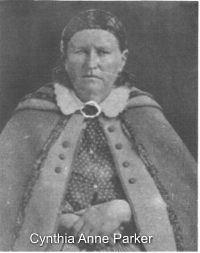 Children under twelve were usually adopted, but older children are not adopted nearly as often. This is because children under the age of twelve can usually learn a new language with complete fluency while older children cannot. This is because of changes that occur in the human brain at about the age of twelve, (btw, this was what I studied when I was doing my graduate work in linguistics long, long before I became a film historian). In other words, young children simply adapted better to adoption by learning the language of their new tribe. However, in some cases, older girls and even adult women were also accepted as members of the tribe. More frequently older girls and women were treated as slaves rather than accepted as full members of the tribe. However, there are quite a number of cases in recorded history where white women captured as young adults were not badly treated and even ended up married to Indian warriors or even chiefs. A great deal depended on how well someone seemed to adjust to the tribe. One captured white woman, Cynthia Anne Parker, even became the mother of the last great Chief of the Comanche, Quanah Parker. There are no cases of adult male captives being adopted into a tribe that I am aware of, but there are cases of adult white males voluntarily joining a tribe (this was in fact was the subject of the Academy Award-winning 1992 film Dances With Wolves).
Children under twelve were usually adopted, but older children are not adopted nearly as often. This is because children under the age of twelve can usually learn a new language with complete fluency while older children cannot. This is because of changes that occur in the human brain at about the age of twelve, (btw, this was what I studied when I was doing my graduate work in linguistics long, long before I became a film historian). In other words, young children simply adapted better to adoption by learning the language of their new tribe. However, in some cases, older girls and even adult women were also accepted as members of the tribe. More frequently older girls and women were treated as slaves rather than accepted as full members of the tribe. However, there are quite a number of cases in recorded history where white women captured as young adults were not badly treated and even ended up married to Indian warriors or even chiefs. A great deal depended on how well someone seemed to adjust to the tribe. One captured white woman, Cynthia Anne Parker, even became the mother of the last great Chief of the Comanche, Quanah Parker. There are no cases of adult male captives being adopted into a tribe that I am aware of, but there are cases of adult white males voluntarily joining a tribe (this was in fact was the subject of the Academy Award-winning 1992 film Dances With Wolves).
Part 4 – When Ethan finally tells Brad and Martin that he already found Lucy dead in the canyon he says that at the time he thought it best not to tell them. Of course, this is why he behaved so strangely when he came back from the canyon and this was why he went there alone. He suspected what had happened. But Ethan only tells Brad and Martin that he found Lucy’s body and buried her. Heartbroken, Brad asks, “Did they…” and of course, he cannot say anymore because he is overcome by emotion, but he also cannot say anymore because the censorship rules were still in place and he could not actually ask, “Was she raped?”. Ethan’s angry answer, “Do you want me to draw you a picture?”, answers the question in the affirmative and also lets us know that it is likely Lucy was also tortured before being killed. This is horrible stuff! Ford is certainly not the only director to make it clear what fate sometimes awaited white women captured by the Indians, but he may be the most consistent in emphasizing this threat in films from Stagecoach and Drums on the Mohawk as well as The Searchers.
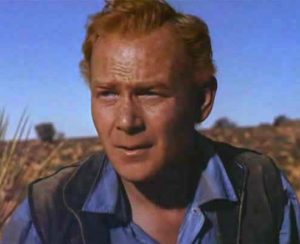 But The Searchers does not just hint at the threat of what might happen, the worst does happen and it is too much for Brad to endure and he rides off in a rage to try to take revenge on the Indians who did this to Lucy. Brad’s rage leads him to a suicidal act. Ethan is just as enraged, but he intends to live to take his revenge. On the other hand, Martin is still focused entirely on rescuing the little girl Debbie.
But The Searchers does not just hint at the threat of what might happen, the worst does happen and it is too much for Brad to endure and he rides off in a rage to try to take revenge on the Indians who did this to Lucy. Brad’s rage leads him to a suicidal act. Ethan is just as enraged, but he intends to live to take his revenge. On the other hand, Martin is still focused entirely on rescuing the little girl Debbie.
In the next scene, Martin narrates in a letter to Brad’s sister (who he is in love with) something that he says he cannot quite figure out. Let’s see if you do.
Part 5 – You remember that I said cowboys in America are a bit like rice farmers in Japan. They hold a special place in the culture. Rice for the Japanese carries enormous symbolic importance. Cattle in America had a similarly important place in the culture. The biggest difference was that rice is an essential food crop in Japan, while Americans could have survived without the beef from cattle. Moreover, in Japan, rice is not simply food, it is something sacred. In contrast to this, Americans never treated the cattle they raised as anything but food. Indians, however, treated the buffalo as a sacred animal.
There is great similarity in the importance of rice to the Japanese and the importance of buffalo to the Indians of the American West. Hunter-gatherers everywhere maintain a very close relationship to nature and view nature itself as sacred. Of all the societies in the world I have studied or experienced, the agricultural society that comes closest to that of the American Indians’ cultures is Japan’s. Shinto and Native American spiritual traditions have many similarities. But, the Indians were not farmers, they were hunters and by far the most important animal they hunted was the buffalo. Rice was terribly important in Japan, but it was possible for the Japanese to survive if their rice crops failed. Also, remember that many poor farmers were forced to give all their rice to their lord and survived on other foodstuffs. In contrast to this, without the buffalo, the Indians literally starved to death. Ethan’s behavior confuses Martin because Martin just wants to rescue Debbie. Ethan, on the other hand, is out for revenge against the Indians…all Indians, not just the ones who took Debbie and Lucy. But Ethan is only an example of the whites did to the buffalo. Now read about how the whites committed ecological genocide against the Indians
It is estimated that before the whites came to North America there were as many as 60,000,000 buffalo roaming the western plains in herds so vast they covered the land of entire states. The Indians never hunted more animals than they could use for food and they also used every part of the buffalo: the hide for clothing and teepees and the bones and horns for tools as well as the meat for food. The whites began hunting buffalo in great numbers after the Civil War. At first, they used the meat and hides much as the Indians had done, but quickly buffalo hunting became a sport where they simply killed the animals and left them to rot.
But it soon became clear to the whites that without the buffalo, the Indians would starve. Just as whites had placed a bounty on the scalps of Indians, they also paid a “bounty” for buffalo hides: $3.00 for cowhides, $2.50 for bull hides, $1.50 for yearlings, and $.75 for calves. In one year, 1870, it is estimated white hunters killed 2,000,000 animals and thereafter the massacres increased every year
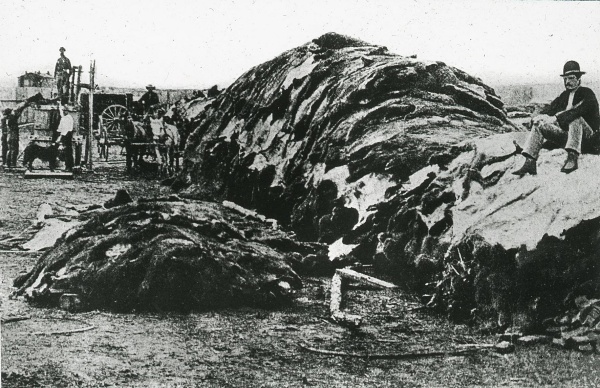
A mountain of buffalo hides
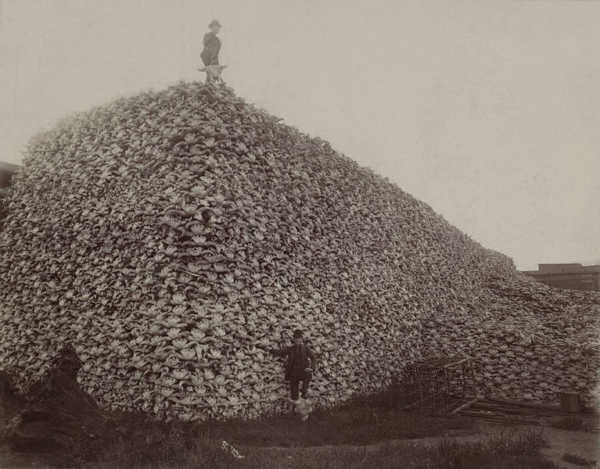
A mountain of buffalo skulls
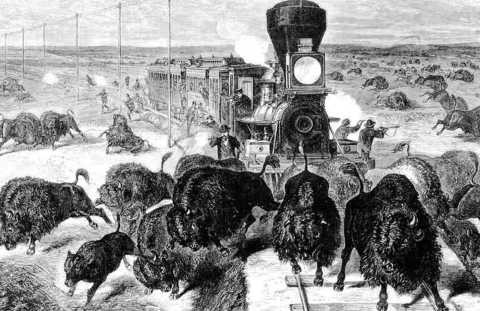
As the railroad moved West, men hunted the buffalo from the windows of the trains, leaving hundreds of dead animals to just rot after the train passed by.
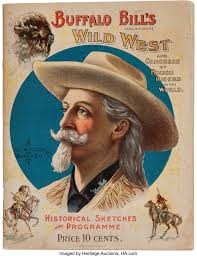 The most famous of the buffalo hunters was “Buffalo Bill” who could kill one hundred buffalo in a single day. Cody would become extremely rich by creating a “Wild West Show” that toured the world. In the show, there would be a mock battle with the Indians in which Cody heroically saved a white woman from the Indians. In real history, however, no one saved the Indians from the mass starvation Cody and the buffalo hunters brought to tens of thousands of Indians.
The most famous of the buffalo hunters was “Buffalo Bill” who could kill one hundred buffalo in a single day. Cody would become extremely rich by creating a “Wild West Show” that toured the world. In the show, there would be a mock battle with the Indians in which Cody heroically saved a white woman from the Indians. In real history, however, no one saved the Indians from the mass starvation Cody and the buffalo hunters brought to tens of thousands of Indians.
By the year 1980, there were only 300 (three hundred) wild buffalo left alive in the American West. They were on the edge of total extinction. The massacre of the American buffalo may possibly be the single greatest ecological crime ever committed in human history. Moreover, the United Nations has just recently (in the year 2018) adopted Resolution 2417, which “strongly condemns starving of civilians” in time of war or conflict. The buffalo massacres were exactly this, a means of starving the civilian population of Indians in what was clearly an attempt at genocide.
Part 6 – Ethan, it is clear, is a white man consumed by his hatred for the Indians and Ford increasingly shows this dark side of Ethan throughout the film. But it isn’t just Ethan who behaves horribly. In the next excerpt, we learn that when Ethan and Martin were asking some Indians about Debbie, it seems there was a misunderstanding. Martin believed the Indians were trying to sell him a blanket. But it is not a blanket Martin bought. Again, the story is “narrated” in the letter Martin sends back to Brad’s family . Brad’s sister, who happens to be in love with Martin, is outraged when she reads about Martin’s “marriage”
Part 7 – Audiences in 1956 laughed at this but I don’t think this is a bit funny. What is supposed to be funny? Is it the fact that this woman was sold as a slave? Do any of you think slavery is something to joke about? Is it the fact that she seems pleasant and loyal to her new husband/master but that he doesn’t want her because she is fat and a bit ugly? Does that make it funny when she is kicked? And this is no gentle kick. He kicks her very, very hard and she rolls down the hill violently. So, let me ask you: is violence against women funny? What did she do to Martin except try to take her place by her husband’s side as she is supposed to do? In his own way, Martin is just as ugly and racist as Ethan.
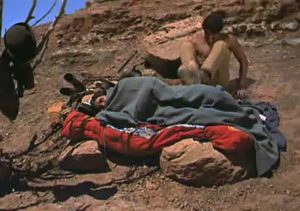 In all the films of John Ford I have ever taught or studied, I believe this scene is the most offensive he ever filmed. It is both racist and sexist at the same time. Ford could not have shown Martin kicking a white woman like this because the censors would never have tolerated it. But because she is “only” an Indian woman being treated this way, they allowed the scene to be included in the movie.
In all the films of John Ford I have ever taught or studied, I believe this scene is the most offensive he ever filmed. It is both racist and sexist at the same time. Ford could not have shown Martin kicking a white woman like this because the censors would never have tolerated it. But because she is “only” an Indian woman being treated this way, they allowed the scene to be included in the movie.
It is largely because of this scene that I refuse to call The Searchers one of Ford’s great films. I feel the scene diminishes the film and reveals the very worst side of John Ford. However, I said Ford was a man of contradictions, and nowhere is that more clear than in the contrast between the scene of the Indian woman being kicked and the next scene. Ethan and Martin have finally found the band of Comanche who are holding Debbie prisoner. They have been looking for this girl for five years and then she suddenly just appears!
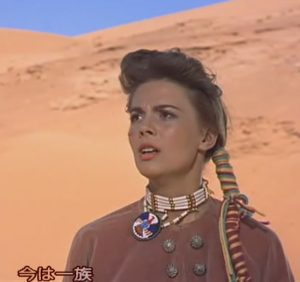 Part 8 – This is a key moment in the film. Ethan and Martin have been searching for this girl for five years and they have at long last found her. Notice that she struggles to remember how to speak English because Comanche has now become her main language and she now considers herself to be Comanche; “these are my people”. When she declares that she has become an Indian, Ethan’s hatred for the Indians proves to be stronger than his love for his family and he draws his gun preparing to kill her. Martin certainly partially redeems himself in this scene by standing in front of her and drawing his own gun to defend her against Ethan. It is only because the Indians have been watching closely that she is saved when one of them shoots Ethan with an arrow. Ford is showing us just how irrational and genuinely evil the hatred of the Indians could become. The Comanche kidnapped this child, but they also adopted her as one of their own. But Ethan will kill a child rather than try to rescue her because she identifies as an Indian. In other words, it is not the Indians who are the worst monsters in this film, it is Ethan in this moment of overwhelming hatred.
Part 8 – This is a key moment in the film. Ethan and Martin have been searching for this girl for five years and they have at long last found her. Notice that she struggles to remember how to speak English because Comanche has now become her main language and she now considers herself to be Comanche; “these are my people”. When she declares that she has become an Indian, Ethan’s hatred for the Indians proves to be stronger than his love for his family and he draws his gun preparing to kill her. Martin certainly partially redeems himself in this scene by standing in front of her and drawing his own gun to defend her against Ethan. It is only because the Indians have been watching closely that she is saved when one of them shoots Ethan with an arrow. Ford is showing us just how irrational and genuinely evil the hatred of the Indians could become. The Comanche kidnapped this child, but they also adopted her as one of their own. But Ethan will kill a child rather than try to rescue her because she identifies as an Indian. In other words, it is not the Indians who are the worst monsters in this film, it is Ethan in this moment of overwhelming hatred.
Yet, Ford doesn’t leave it there. At the end of the film, they once again find the Indians and Martin attempts to rescue Debbie.
Part 9 – It is a terrifying moment as he grabs her. We are almost certain he will kill her….but as he holds her up in the air we remember this is the way he held her in the air when he thought she was Lucy. It seems to trigger his memory and he remembers that this little girl is his niece, his family. Ethan’s good side at last defeats his dark side, almost like Shane defeating Wilson, only this time the battle was all inside Ethan. Is Ford telling us that even someone as racist as Ethan can be redeemed? It is a moment of great drama, but I am not sure it is truthful filmmaking. I am not sure racism is so easily overcome. That is something for you to reflect on.
When John Ford made Stagecoach and Drums Along The Mohawk he was forty-five years old. He had already won an Oscar for best director and he would go on to win three more. He would continue to make films for another twenty-seven years. But as I have already said, Ford would gradually change over time. When Ford turned seventy, he seemed to look back on his long career and regret the way he had depicted the Indians in his films. More than anyone else, John Ford was responsible for the image of the Indian Hollywood had created. In 1964, he no longer wanted to “print the legend” he wanted to tell the truth! He would attempt to do just that in his last Western, Cheyenne Autumn (1964). The film is a serious attempt to tell the truth about what happened to the tribe that defeated Custer at the Battle of the Little Big Horn, the Cheyenne.
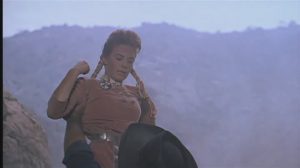
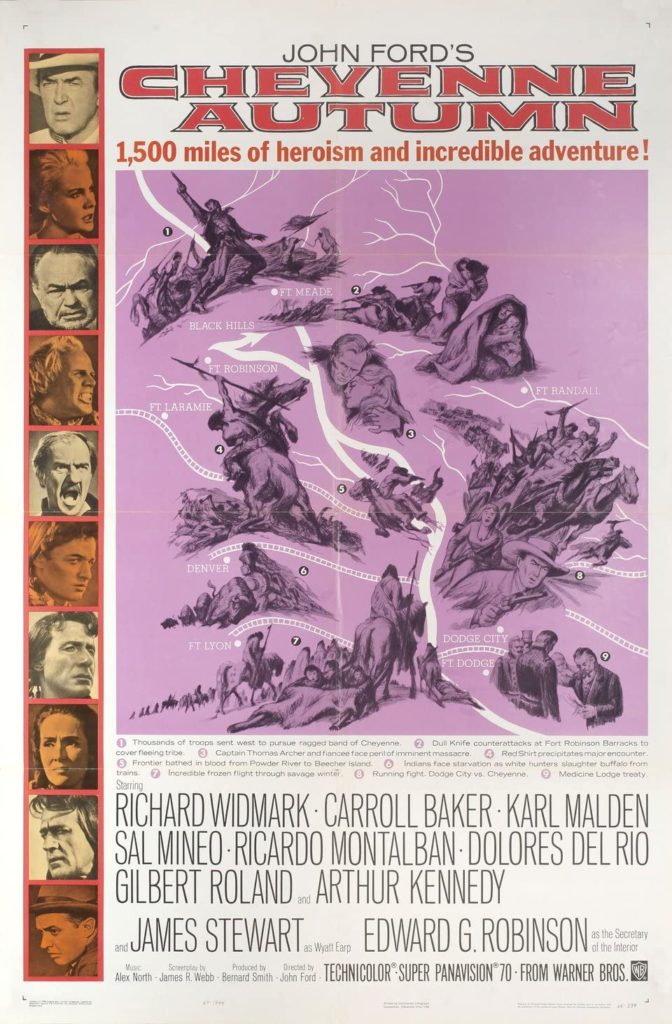
Directed and produced by John Ford
Written by Mari Sandoz (non-fiction history) James R. Webb
Based on The Last Frontier 1941 novel by Howard Fast
Starring Richard Widmark, Carroll Baker, James Steward, Dolores del Rio, Edward G. Robinson, Karl Malden
Music by Alex North
Running time: 154 minutes
Box office: $3,500,000
Part 10 – The Cheyenne decide to escape. In a complete reversal of how white women usually fear the Indians and scream as soon as they see them, the Quaker woman asks the chiefs to go with them because she is also a nurse and wants to look after the sick. They accept her offer and she escapes with them. Captain Archer is given the duty of catching the Indians and bringing them back. The rest of the film is seen through the Quaker woman’s eyes or the eyes of Captain Archer. She is witness to the Indians’ suffering. Archer is witness to the abuse of power and corruption. The problem is that we have blue-eyed witnesses to the sufferings of brown-skinned people. Ford was not able to make the jump to allowing the Indians to be the stars of their own story. Perhaps he believed a white audience would not watch such a film, perhaps he just was not capable of making such a film.
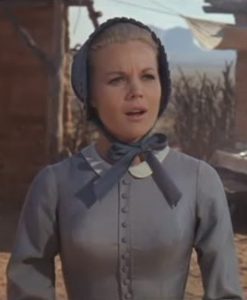 Cheyenne Autumn was John Ford’s final Western and was a project he took very seriously. It was both his longest and most expensive film. Ford may have thought of it as the capstone of his career and may even have hoped it would be seen as his greatest work. One critic called it “Ford’s attempt at personal redemption” for all the films he made in which the Indians were stereotyped and vilified. Whatever else it is, it is a sincere effort. However, John Ford, possibly Hollywood’s greatest director, failed badly in his last Western. The film was both a commercial failure (it didn’t make a profit) and a critical one, (it received almost universally poor reviews). Like Ransom Stoddard, Ford finally tried to tell the truth, but no one wanted to hear it. America in 1964 was unwilling to hear the truth about the Indians, even if it was John Ford telling it to them.
Cheyenne Autumn was John Ford’s final Western and was a project he took very seriously. It was both his longest and most expensive film. Ford may have thought of it as the capstone of his career and may even have hoped it would be seen as his greatest work. One critic called it “Ford’s attempt at personal redemption” for all the films he made in which the Indians were stereotyped and vilified. Whatever else it is, it is a sincere effort. However, John Ford, possibly Hollywood’s greatest director, failed badly in his last Western. The film was both a commercial failure (it didn’t make a profit) and a critical one, (it received almost universally poor reviews). Like Ransom Stoddard, Ford finally tried to tell the truth, but no one wanted to hear it. America in 1964 was unwilling to hear the truth about the Indians, even if it was John Ford telling it to them.
It was not until Arthur Penn, (the director of The Left-handed Gun) made his film Little Big Man in 1970 that American audiences were willing to watch a film about what they had really done to the Indians. If you have enjoyed the films I have shown you in this class and would like my recommendation for a film I know you will enjoy and learn from, please watch this film. It is a very different kind of Western than any we have seen in this class. Sadly, we do not have time to discuss it because we have reached the end of our time together.
Let me finish by saying it has been my pleasure to be your teacher this year and I hope you have enjoyed this class, learned some English, learned something about films, and learned something about American culture (the good along with the bad). Thank you all for your attention and hard work. Please stay safe and be well.